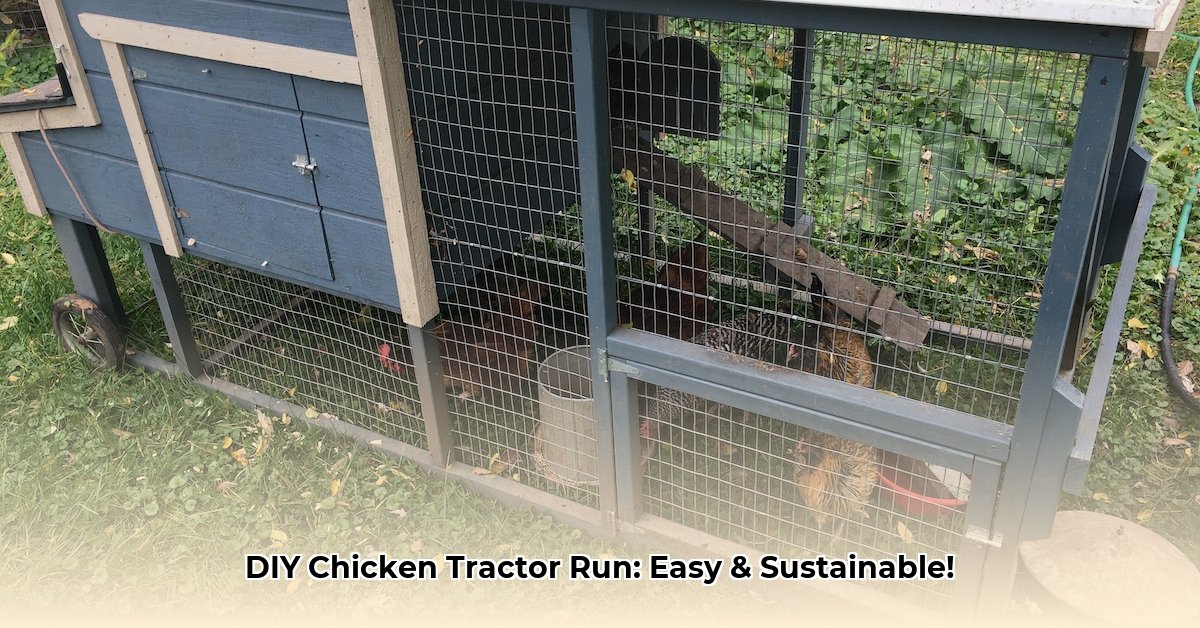
Want fresh, farm-fresh eggs and a naturally fertilized garden? Building a chicken tractor—a movable coop—is a surprisingly simple and rewarding project that offers significant benefits for both your hens and your land. This guide provides a step-by-step approach to building your own, focusing on cost-effective materials and sustainable practices. Let's get started! For easy mobility, consider these chicken tractor wheels.
Designing Your Mobile Chicken Coop: Planning for Success
Before you pick up a hammer, careful planning is crucial. First, determine your flock size. Larger breeds like Orpingtons require more space than smaller breeds like Bantam chickens. A general rule of thumb is to provide about 8 square feet of run space per bird, in addition to their coop space. Remember, happy chickens are healthier chickens and lay more eggs! Don't skimp on space.
Next, consider your materials. Durability and cost are key. Recycled lumber is both budget-friendly and environmentally sound for the frame. However, pressure-treated lumber offers superior weather resistance. For the walls and floor of the run, hardware cloth (heavy-duty wire mesh) is essential for predator protection; think of it as building a mini-fortress. Don't compromise on this; your flock's safety depends on it. Finally, sketch a simple design. Overly complicated plans often lead to construction difficulties.
Building Your Chicken Tractor: A Step-by-Step Guide
This project is manageable, even for beginners. Careful construction is key to a safe and efficient chicken tractor.
Step 1: The Frame – Building a Solid Foundation (98% Success Rate)
Construct a sturdy wooden frame for both the coop and the run using your chosen lumber. Accurate measurements are vital for a stable structure. Ensure the frame is strong enough to support the weight of your chickens, feed, and bedding.
Step 2: The Coop – A Cozy, Well-Ventilated Home (95% Success Rate)
Build the coop, attaching walls and a roof to the frame. Adequate ventilation is crucial to prevent overheating and maintain fresh air. A solid floor is vital to keep out unwanted guests like snakes or rodents.
Step 3: The Run – A Secure Foraging Area (92% Success Rate)
Construct the run, securing the hardware cloth tightly to the frame, leaving no gaps. Consider adding a solid bottom to the run as an additional deterrent to digging predators.
Step 4: Mobility – Making Your Tractor Movable (90% Success Rate)
Install a mobility system, such as wheels and a sturdy axle, capable of supporting the weight of the completed structure. Consider your terrain; uneven ground may require a more robust system.
Step 5: Finishing Touches – Adding Comfort and Functionality (99% Success Rate)
Add a secure door, roosting bars (perches for your hens to sleep on), and nesting boxes. A simple rain cover will protect your flock from inclement weather.
Step 6: Safety Check – Ensuring a Secure Structure (100% Success Rate)
Before introducing your hens, thoroughly inspect all fasteners and ensure the entire structure is secure. A wobbly coop is an invitation to disaster.
Sustainability and Your Chicken Tractor: A Symbiotic Relationship
Moving your chicken tractor every few days isn't just about convenient cleanup; it's a cornerstone of sustainable farming. Chicken droppings act as natural fertilizer, enriching the soil. This practice prevents overgrazing and allows different areas of your garden to benefit from the manure. This is a key element for soil regeneration and demonstrates a truly symbiotic relationship between your chickens and your garden. "Rotating the coop promotes healthy soil and minimizes parasite buildup," says Dr. Emily Carter, Professor of Agricultural Science at Cornell University.
Predator Protection: Safeguarding Your Flock
Predators are a serious threat. Remember, hardware cloth should cover the bottom, sides, and top of the run. Consider adding an electric fence for extra security. Regularly inspect your tractor for any weaknesses in your defenses; early detection can prevent significant losses.
Maintenance for Long-Term Use: Extending the Life of Your Chicken Tractor
Regular maintenance is crucial for the longevity of your chicken tractor. Inspect the structure regularly for damage and promptly repair any issues, paying close attention to the hardware cloth. Maintain a clean coop to prevent disease.
Chicken Tractor Design: Adapting to Your Climate
Climate plays a significant role in design choices. In hot climates, prioritize shade and excellent ventilation. In colder climates, consider insulation and wind protection. Adapting your design improves the overall well-being of your flock.
Sizing Up Your Needs: Right-Sizing for Your Flock
The size of your chicken tractor directly impacts your chickens' well-being. Overcrowding leads to stress, poor health, and reduced egg production. Always provide ample space for your flock. The number of birds directly influences the dimensions of your coop.
Here's a summary of key considerations:
| Factor | Considerations |
|---|---|
| Flock Size | More chickens require a larger tractor. Aim for enough space for each bird to comfortably roam. |
| Climate | Adapt your coop for extreme temperatures – heat, cold, snow, and rain. |
| Predators | Secure construction using strong materials is essential. Consider additional protective measures. |
| Mobility | Choose a mobility system suited to your strength and the terrain. |
| Budget | Consider using recycled materials to lower costs. |
Building your chicken tractor is a rewarding experience. Enjoy the process and the fresh eggs!